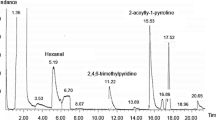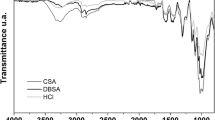Abstract
In this study, the nutritional and volatile compositions of several rice varieties classified by endosperm type were analyzed. The rice analyzed were a hard type (Ilpum), three soft types (Seolgaeng, Hangaru, and Shingil), and a floury type (Baromi 2). The general composition, fatty acids, and amino acid content of each rice variety was determined. An electronic nose (e-nose) was used for the volatile analysis. Correlation analyses of the aroma patterns of the rice flours were conducted. The nutritional components contributing to changes in the aroma patterns of the rice after milling were investigated. Principal component analysis (PCA) confirmed that the aroma patterns of hard rice and floury rice before and after milling were significantly different, with these groups being clearly distinguished. Strong negative or positive correlations were observed between the metal oxide semiconductor (MOS) sensors that detect fragrance and four fatty acids (oleic, arachidic, gadoleic, and lignoceric acids). The results demonstrated that milled floury rice and soft rice showed different fragrance patterns despite both types of rice being used for flour production. We also found that the primary nutritional components involved in the fragrance patterns were the four fatty acids.



Similar content being viewed by others
References
AOAC (2006) Official methods of analysis of AOAC intl, 18th edn. Association of Official Analytical Chemists, Washington, USA
Bergman CJ, Delgado JT, Bryant R, Grimm C, Cadwallader KR, Webb BD (2000) Rapid gas chromatographic technique for quantifying 2-acetyl-1-pyrroline and hexanal in rice (Oryza sativa, L.). Cereal Chem 77:454–458
Cho YS (2002) Application of electronic nose in discrimination of the habitat for black rice. Korean J Food Sci Technol 34(1):136–139
Cho JH (2018) Good market prospects because Singil rice is easy to make into flour. Horticulture. Available from http://www.hortitimes.com/news/articleView.html?idxno=8337. Accessed 15 Oct 2018 (in Korean)
Cho YC, Baek MK, Park HS, Cho JH, Ahn EK, Suh JP, Jeung JU, Lee JH, Won YJ, Song YC, Jeong EG, Kim BK, Lee JH (2020) History and results of rice breeding in Korea. Korean J Breed Sci 52(S):58–72
Choi SY, Shin MS (2009) Properties of rice flours prepared from domestic high amylose rices. Korean J Food Sci Technol 41(1):16–20
Choi OJ, Jung HN, Shim KH (2015) Physicochemical properties of powdered, soft and hard type rice flour by different milling methods. Korean J Food Preserv 22(2):174–181
Di Natale C, Macagnano A, Paolesse R, D’Amico A (2001) Artificial olfaction systems: principles and applications to food analysis. Biotechnol Agron Soc Environ 5:159–165
Folch J, Lees M, Stanley GHS (1957) A simple method for the isolation and purification of total lipids from animal tissues. J Biol Chem 226(1):497–509
Gardner JW, Hines EL (1997) Pattern analysis techniques. In: Kress-Rogers E (ed) Handbook of biosensors and electronic noses: medicine, food, and the environment. CRC Press Inc., Frankfurt, Germany, pp 633–652
Han HJ, Dong H, Noh BS (2016) Discrimination of rice volatile compounds under different milling degrees and storage time using an electronic nose. Korean J Food Sci Technol 48(2):187–191
Han CM, Shin JH, Kim SK, Kwon TY, Kim JS (2018) Influence of different transplanting dates on amylopectin branch-chain-length and pasting properties of rice flour varieties. Korean J Crop Sci 63:210–218
Hong SI (2017) Rice flour is the general trend. Available from https://blog.naver.com/rda2448/221002612962. Accessed 10 May 2017 (in Korean)
Hong HC, Moon HP, Choi HC, Hwang HG, Kim YG, Kim HY, Yea JD, Shin YS, Kang KH, Choi YH, Cho YC, Baek MK, Yang CI, Choi IS, Ahn SN, Yang SJ (2011) A lodging tolerant, opaque rice cultivar ‘Seolgaeng.’ Korean J Breed Sci 43:532–537
Hwang W, Choi M, Jeong J, Lee H, Yang S, Lee C (2021) Investigation of the optimum transplanting date for floury endosperm rice to reduce the viviparity rate. Korean J Crop Sci 66(4):289–296
Jeung JU (2019) Don’t soak ‘Garumi rice’ in water. Available from http://www.korea.kr/news/pressReleaseView.do?newsId=156347637&call_from=naver_news. Accessed 28 Aug. 2019 (in Korean)
Jeung JU, Shin YS (2011) Evaluations on the Namil (SA)-flo1, a floury japonica rice line, for dry milling process to produce rice flour. Korean J Crop Sci 56(1):57–63
Kang H, Park S, Matsuoka M, An G (2005) White-core endosperm floury endosperm-4 in rice is generated by knockout mutations in the C4-type pyruvate orthophosphate dikinase gene (OsPPDKB). Plant J 42(6):901–911
Lee DD (2003) Technology and application of olfactory sensor system. Control Instrum 2:20–23
Lee R (2018) Nutritional composition of rice bread with different rice flours. Korean J Food Nutr 31:435–440
Lee DS, Noh BS, Bae SY, Kim K (1998) Characterization of fatty acids composition in vegetable oils by gas chromatography and chemometrics. Anal Chim Acta 358:163–175
Lee JY, Kang JW, Jo SM, Kwon YH, Lee SM, Lee SB, Shin DJ, Park DS, Lee JH, Ko JM (2021) Screening and breeding for biofortification of rice with protein and high lysine contents. Plant Breed Biotechnol 9(3):199–212
Mo YJ, Jeung JU, Shin YS, Park CS, Kang KH, Kim BK (2013) Agronomic and genetic analysis of Suweon 542, a rice floury mutant line suitable for dry milling. Rice 6(1):1–12
Mosse J (1990) Nitrogen-to-protein conversion factor for ten cereals and six legumes or oilseeds. A reappraisal of its definition and determination. Variation according to species and to seed protein content. J Agric Food Chem 38(1):18–24
Noh BS (2005) Analysis of volatile compounds using electronic nose and its application in food industry. Korean J Food Sci Technol 37:1048–1064
Peris M, Escuder-Gilabert L (2009) A 21st century technique for food control: electronic noses. Anal Chim Acta 638(1):1–15
Pomeranz Y (2012) Lipids in cereal products, functional properties of food components, 2nd edn. Academic Press, Washington, p 277
Ruibal-Mendieta NL, Dekeyser A, Delacroix DL, Mignolet E, Larondelle Y, Meurens M (2004) The oleate/palmitate ratio allows the distinction between wholemeals of spelt (Triticum spelta L.) and winter wheat (T. aestivum L.). J Cereal Sci 39(3):413–415
Seo JS, Cho SH (2008) Rice-based traditional meal and prevention of chronic diseases. Food Ind Nutr 13:27–33
Sim EY, Park HY, Kim MJ, Lee CK, Jeon YH, Oh SK, Won YJ, Lee JH, Ahn EK, Woo KS (2017) Studies on the palatability and texture of Korean rice cultivars for the cooked-rice processing. Korean J Food Nutr 30:880–888
Sung J, Kim H, Choi H, Kim Y (2011) Fat acidity and flavor pattern analysis of brown rice and milled rice according to storage period. J Korean Soc Food Sci Nutr 40(4):613–617
Wei Z, Xiao X, Wang J, Wang H (2017) Identification of the rice wines with different marked ages by electronic nose coupled with smartphone and cloud storage platform. Sensors (switzerland) 17(11):2500
Won YJ, Ahn EK, Jeong EG, Chang JK, Lee JH, Jung KH, Hyun UJ, Cho YC, Oh SK, Yoon MR, Kim BK, Kim BJ (2019) An opaque endosperm rice cultivar, ‘Hangaru’, suitable for exclusive dry-milling rice flour production. Korean J Breed Sci 51:134–139
Won YJ, Ahn EK, Jung KH, Hong HC, Hyun UJ, Park HM, Yoon MR, Lee JH, Seo JP, Jeong EG, Chang JK, Kwak JE, Oh SK (2020) Agricultural characteristics of ‘Misiru’ with improved dry-milling rice flour trait. Korean J Breed Sci 52:151–157
Xu J, Liu K, Zhang C (2021) Electronic nose for volatile organic compounds analysis in rice aging. Trends Foods Sci Technol 109:83–93
Yang DS, Lee KS, Kays SJ (2010) Characterization and discrimination of premium-quality, waxy, and black-pigmented rice based on odor-active compounds. J Sci Food Agric 90:2595–2601
Yeoh H, Truong V (1996) Protein contents, amino acid compositions and nitrogen-to-protein conversion factors for cassava roots. J Sci Food Agric 70(1):51–54
Yoon MR (2009) Properties of starch-lipid and lipid components in rice endosperm affected on eating quality. PhD thesis. Kyungpook National University, Daegu
Zhou B, Wang J (2011) Discrimination of different types damage of rice plants by electronic nose. Biosyst Eng 109(4):250–257
Author information
Authors and Affiliations
Corresponding author
Ethics declarations
Conflict of interest
The authors declare that they have no conflict of interest.
Additional information
Publisher's Note
Springer Nature remains neutral with regard to jurisdictional claims in published maps and institutional affiliations.
Supplementary Information
Below is the link to the electronic supplementary material.
Rights and permissions
Springer Nature or its licensor (e.g. a society or other partner) holds exclusive rights to this article under a publishing agreement with the author(s) or other rightsholder(s); author self-archiving of the accepted manuscript version of this article is solely governed by the terms of such publishing agreement and applicable law.
About this article
Cite this article
Han, CM., Shin, JH., Kim, SK. et al. Analysis of volatile compounds of several rice varieties according to endosperm type using an electronic nose. J. Crop Sci. Biotechnol. 26, 359–367 (2023). https://doi.org/10.1007/s12892-022-00184-y
Accepted:
Published:
Issue Date:
DOI: https://doi.org/10.1007/s12892-022-00184-y




